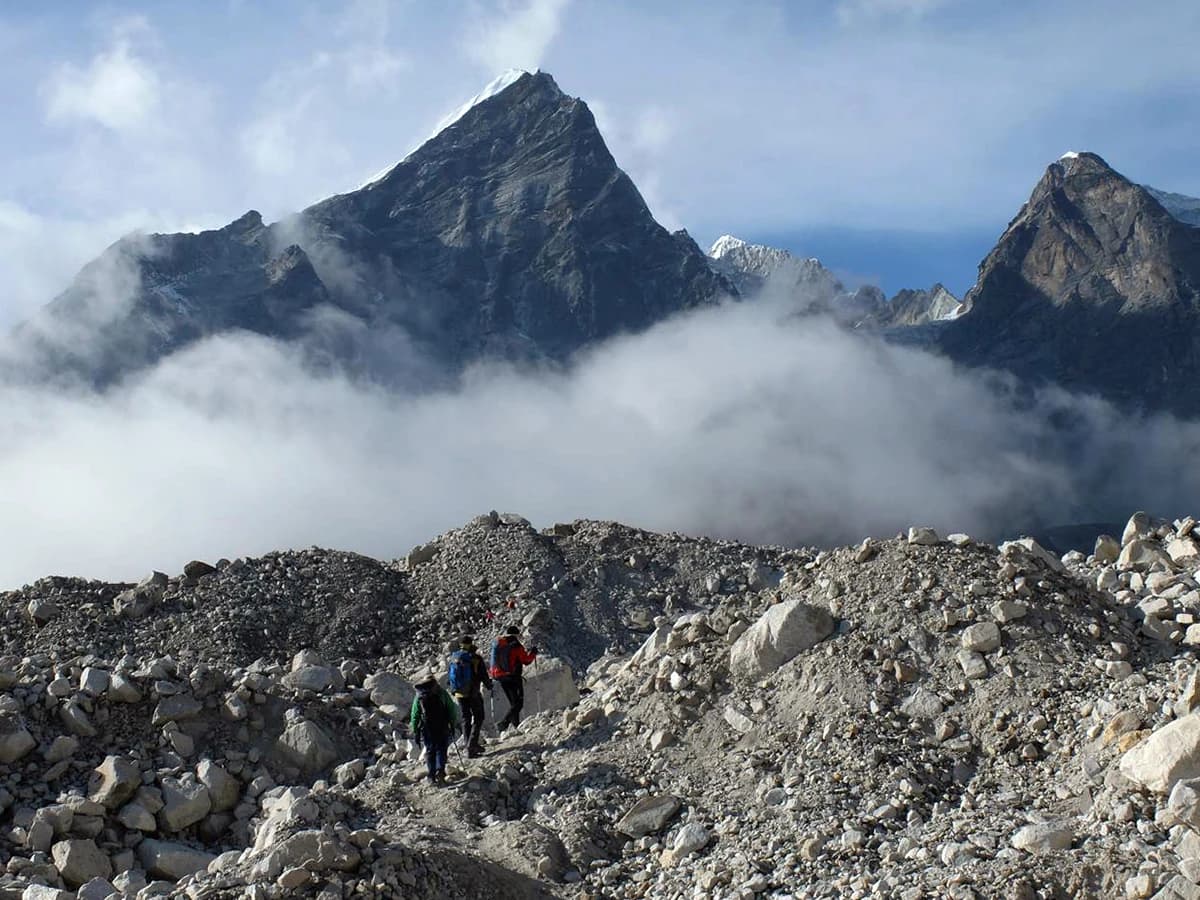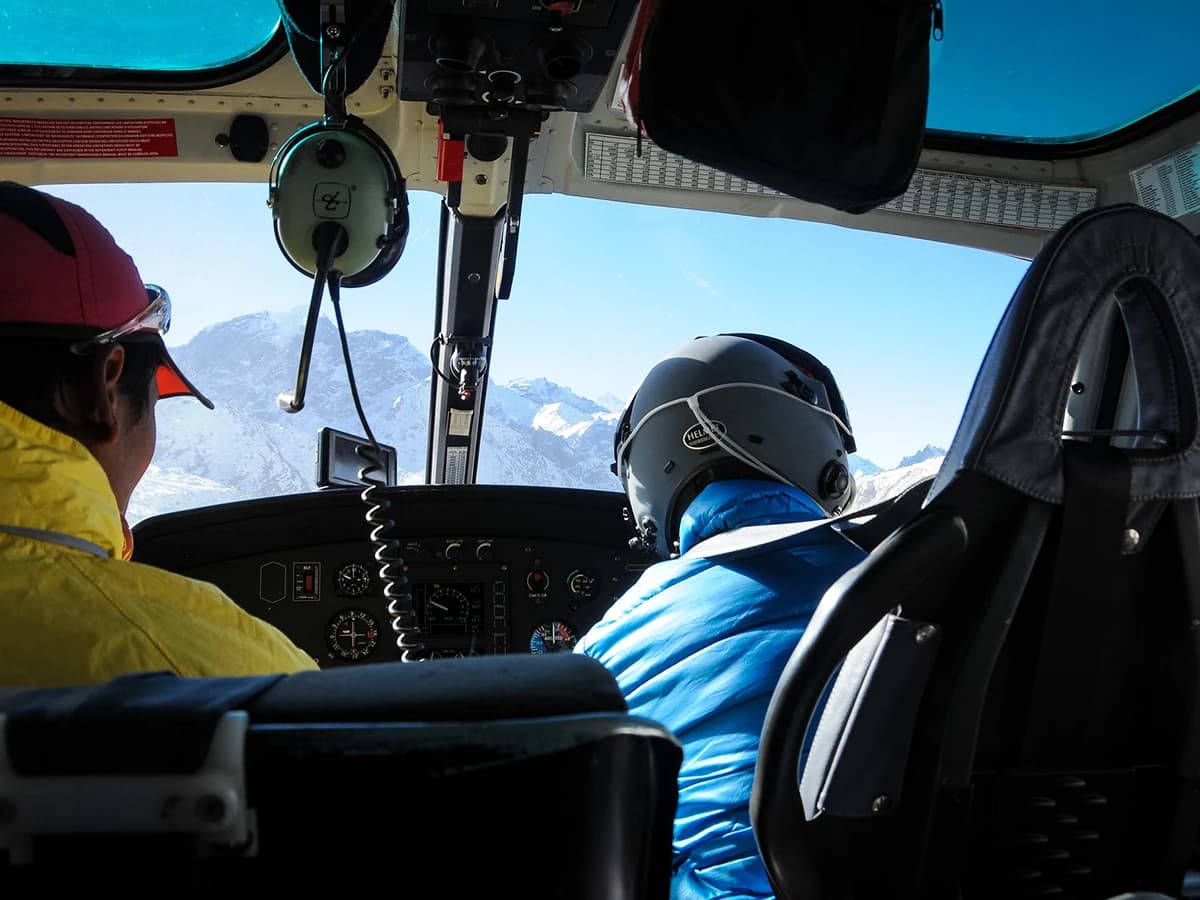The Everest Base Camp Trek and Island Peak Climb with Heli Shuttle is an epic journey that guarantees adventure like never before, reaching the base camp of the highest mountain in the world, Mount Everest, and one of the six thousanders, Island Peak (6,165m). The challenges, rewards, and, as you return with a heli shuttle, the comfort as well, mean you are signing up for unforgettable memories to cherish for a lifetime. Based on the 16-day Everest Base Camp Trek and Island Peak Climbing with Heli Shuttle Itinerary, trekkers at first traverse through the classic Everest Base Camp Trekking routes, passing Sherpa villages, monasteries, and stunning mountain views before climbing the Island Peak. Along the trail, you will cross the suspension bridges along the Dudh Koshi River and acclimatize in bustling Sherpa villages like Namche Bazaar and Dingboche. This trek consists of adventure and steep climbs involving fixed ropes and crampons, rewarding breathtaking views of the Himalayas.
Beginning typically with a thrilling flight to Lukla directly from Kathmandu, offering stunning views, trekkers and climbers gradually ascend to Everest Base Camp through the Sherpa villages like Namche Bazaar, Pangboche, Dingboche, etc. This Everest Base Camp Trekking and Island Peak Climbing with Heli Shuttle itinerary of 16 days is carefully designed for better acclimatization and a high success rate. While you are here, trekking to Kalapthar and enjoying the best sunrise views of Everest is a must, which offers 360-degree close-up views of the surrounding Himalayan peaks, including Mount Everest itself. Thereafter, you will head towards Island Base Camp, prepare yourself for the final push, and learn how to climb using rope, crampons, etc. After the Island Peak summit, you will descend down to the base camp and come back to Lukla in a helicopter, enjoying the bird's-eye view of the trail you trekked hard to reach the Everest base camp and Island Peak.
Further at Skybound Adventure, our Everest Base Camp Trek and Island Peak Climb with Heli Shuttle cost is reasonably priced so you get to experience panoramic views, adventure, the raw beauty of nature, a chance to immerse yourself in Sherpa culture, and a chance to know yourself without breaking the bank, including for the years 2025 and 2026. Get an early bird and group discounts on this Everest Base Camp Trekking and Island Peak Climbing with Heli Shuttle Cost for 2025 and 2026 spring and autumn. Possessing more than a decade of high-altitude trekking, climbing, and hiking in the stunning Himalayas of Nepal, your journey can be unforgettable and smoother. Book with Skybound Adventure for a hassle-free Himalayan holiday experience.
What to expect during trekking to Everest Base Camp and climbing Island Peak with a heli shuttle?
The trek to Everest Base Camp and Island Peak climb with heli shuttle is an Everest adventure package especially crafted by Skybound Adventure so trekkers and climbers can save time and energy after an adrenaline-rushing hike to the base of the highest mountain in the world, Mount Everest (8,848.86m), and summit to Island Peak. As one of the leading travel, trek, and expedition companies in Nepal, we do our best to make sure things go as planned, including the 16-day Everest Base Camp trek and Island Peak climbing with a Heli shuttle itinerary. But it is always necessary to remain flexible for changes due to situations arising from things beyond human control, such as Lukla flight delays and cancellations due to bad weather, and alterations in routes as a result of natural disasters.
Otherwise, blessing you with the amazing panorama of snow-capped mountain peaks, lush valleys, and rich Sherpa culture, the Everest Base Camp Trekking and Island Peak Climbing with Heli Shuttle is an opportunity for a thrilling Himalayan odyssey to remember for a lifetime. After mentally and physically demanding parts such as steep ascents and descents, rugged terrain, and potentially snowy or icy trails, specifically in and around Everest Base Camp and Island Peak. The adventure continues as you board a helicopter back to Lukla; you will be in love with the Khumbu region and its different aerial views. The helicopter return not only serves as transportation but also serves as a memory that allows you to reflect on the magnificent view of Mount Everest before getting back to Kathmandu.
Everest Base Camp and Island Peak Climbing with Heli Shuttle—Is this trip right for you?
Yes, if you are someone seeking high-altitude trekking and non-technical mountaineering followed by comfort, the trek to Everest Base Camp and Island Peak climb with a helicopter shuttle is your perfect journey to the Everest Himalayas. A healthy individual who has invested themselves in months of preparation, proper planning, and the right partner for the epic Himalayan voyage, with or without prior trekking and climbing, can complete the trip. It can be just the right introduction you are looking for to sharpen your mountaineering skills for future expeditions. But one must have a strong desire for challenge and push oneself beyond limits. Old or young, if you have developed endurance for high-altitude treks and climbs, a lot of stamina, and do not suffer from illnesses related to the heart and lungs, yes Everest Base Camp Trek and Island Peak Climbing with Heli Shuttle are for you. Experience both the cultural richness and physical richness of the Everest region with expert support and safety at Skybound Adventure.
How to prepare yourself for the combined trip to Everest Base Camp and Island Peak Climbing?
To ensure you have what it takes for an epic Everest Himalayan hiking and climbing experience, begin to train yourself physically and mentally 3 to 6 months before the official high-altitude trekking and climbing departure day. Start by running, swimming, cycling, and hiking once a week, and for cardiovascular endurance, consider hiking to high-altitude local terrain carrying a bag to get a real feel for trekking, climbing stairs, etc. Leg strengthening is a must, and squats, lunges, and planks to handle steep ascents and descents while carrying your trekking gear are wise things to do. If possible, you must try high-altitude trekking so you get a taste of alpine rambling to Everest Base Camp and Island Peak, and also understand the tactics to overcome altitude sickness.
For the Island Peak climb alone, you might want to learn to use mountaineering gear like crampons, ice axes, self-arrest, and fixed rope techniques. Skybound Adventure does provide you with training sessions led by professional guides, but you might want to make sure you are ready for the demands that Everest hiking and climbing put you through. Other than physical preparedness, you have to make up your mind for a long day's trek and basic accommodations. Consider doing yoga or meditation. A progressive 6-month training will be perfect to make your Everest Base Camp and Island Peak climbing trek easier and more comfortable.
What gear should you pack for the Everest Base Camp Trek and Island Peak climbing adventure?
Packing properly is and always will be an essential part of the Everest Base Camp and Island Peak climbing preparation that ensures your comfort and success. Pack light, pack smart with only those things that are required, including trekking gear and mountaineering equipment. Follow the layering principle for clothing. Starting from the top, consider including a moisture-wicking layer at the base, followed by an insulating jacket in the middle, like a fleece jacket, and for the top, you must have a jacket that is waterproof and windproof. For the lower body, wind- and waterproof trekking pants, half-trekking pants, and t-shirts to wear while in the teahouse. For the foot, buy waterproof trekking boots that have nice ankle support and are compatible with crampons, mandatory for glacier and steep ice sections. Bring some climbing gear, like a climbing harness, crampons, an ice axe, and a helmet to protect yourself against falling ice or heavy snow for Island Peak climbing.
Warm gloves are to avoid frostbite, sunglasses to avoid snow blindness, and a neck gaiter to protect your neck from the cold. Headlamps with extra batteries and first aid, including medicines for altitude sickness, are other essentials to include in your Everest Base Camp Trekking and Island Peak Climbing with Heli Shuttle packing list, including for the years 2025 and 2026. As the weather in the mountains can be unpredictable, you carry your own sleeping bag, and how fun to be with Skybound Adventure, where we provide you all the essential trekking and climbing gear, including a sleeping bag, as part of our hike to Everest Base Camp and Island Peak Climbing with Heli Shuttle package. If you are buying for yourself, then to make your body stable on rocky trails, trekking poles, a reusable bottle to stay hydrated, along with water purification tablets, high-SPF sunscreen, and toiletries, and to pack all this, a 30- to 45-liter capacity backpack will do the work for you.
Begin your unforgettable adventurous journey: Book the Everest Base Camp Trek and Island Peak climbing!
Ready for the unforgettable lifetime journey? Join us today on an adventurous journey to Everest Base Camp Trek that further takes you to climb one of the six-thousanders of Nepal, Island Peak (6,165m), also called Imja Tse. Trekkers and climbers along the routes get to immerse themselves in the Sherpa culture, walk through the raw beauty of nature, and meet friendly locals of the Himalayas. You will trek to Everest Base Camp for an extraordinary view of Mount Everest and then climb Island Peak, which is a real adventure. Don't worry if you don't know how to use mountaineering equipment; our expert guides will teach you everything before the climb. Every day, the long day treks with different challenges can be tiring, but it will all be worth it after getting the panoramic views of the mountains on the way. At night, as you get to appreciate the beauty of the clearest star you may have ever seen, for anyone seeking adventure, someone who loves nature and is ready to face the challenge, Everest Base Camp Trekking and Island Peak climbing with a heli shuttle giving you a perfect, comfortable ending is worth everything. Feel free to contact Skybound Adventure, as we will take care of everything, making your dream into reality.


